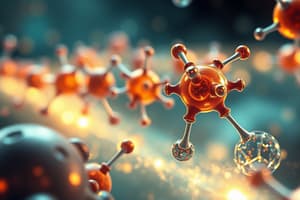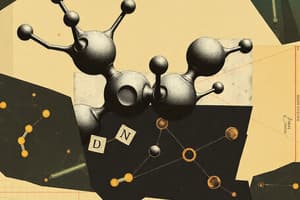Podcast
Questions and Answers
What is the primary function of the cell wall in plant cells?
What is the primary function of the cell wall in plant cells?
- To synthesize ATP during cellular respiration
- To facilitate photosynthesis in chloroplasts
- To regulate the entry and exit of substances
- To provide structural support and protection (correct)
Which stage of cellular respiration directly produces the most ATP?
Which stage of cellular respiration directly produces the most ATP?
- Glycolysis
- Electron Transport Chain (correct)
- Fermentation
- Krebs Cycle
What type of cell division results in genetically identical daughter cells?
What type of cell division results in genetically identical daughter cells?
- Binary Fission
- Mitosis (correct)
- Budding
- Meiosis
What occurs during prophase I of meiosis that increases genetic diversity?
What occurs during prophase I of meiosis that increases genetic diversity?
Which of the following statements about fermentation is true?
Which of the following statements about fermentation is true?
What is the primary function of carbohydrates in living organisms?
What is the primary function of carbohydrates in living organisms?
Which organelle is responsible for ATP production?
Which organelle is responsible for ATP production?
What components make up nucleotides in nucleic acids?
What components make up nucleotides in nucleic acids?
Which type of macromolecule includes fats, oils, and steroids?
Which type of macromolecule includes fats, oils, and steroids?
The rough endoplasmic reticulum is primarily involved in which process?
The rough endoplasmic reticulum is primarily involved in which process?
What is the function of lysosomes in a cell?
What is the function of lysosomes in a cell?
Which structure acts as the selectively permeable boundary of the cell?
Which structure acts as the selectively permeable boundary of the cell?
What determines the function of a protein?
What determines the function of a protein?
Flashcards
What is ATP?
What is ATP?
The primary energy currency of the cell, storing energy in phosphate bonds. Hydrolysis (breaking) of ATP releases energy for cellular processes.
What is Cellular Respiration?
What is Cellular Respiration?
Process by which cells break down glucose to produce ATP. Includes glycolysis, the Krebs cycle, and the electron transport chain.
What is Photosynthesis?
What is Photosynthesis?
Process by which plants and some organisms use sunlight to synthesize sugar from carbon dioxide and water. Happens in chloroplasts.
What is Mitosis?
What is Mitosis?
Signup and view all the flashcards
What is Meiosis?
What is Meiosis?
Signup and view all the flashcards
Carbohydrates
Carbohydrates
Signup and view all the flashcards
Lipids
Lipids
Signup and view all the flashcards
Proteins
Proteins
Signup and view all the flashcards
Nucleic Acids
Nucleic Acids
Signup and view all the flashcards
Plasma Membrane
Plasma Membrane
Signup and view all the flashcards
Cytoplasm
Cytoplasm
Signup and view all the flashcards
Nucleus
Nucleus
Signup and view all the flashcards
Mitochondria
Mitochondria
Signup and view all the flashcards
Study Notes
Macromolecules
- Carbohydrates are composed of carbon, hydrogen, and oxygen.
- They are a primary energy source and structural component.
- Types include monosaccharides (simple sugars), disaccharides (two sugars), and polysaccharides (many sugars).
- Examples: glucose, sucrose, starch, and cellulose.
- Lipids are hydrophobic molecules primarily composed of carbon and hydrogen.
- They include fats, oils, phospholipids, and steroids.
- Functions include energy storage, cell membrane components, and hormone production.
- Proteins are complex polymers formed from amino acids.
- Crucial for structural support, enzymatic activity, transport, and defense.
- Different protein structures (primary, secondary, tertiary, quaternary) determine function.
- Nucleic acids include DNA and RNA, encoding genetic information.
- DNA stores genetic information, RNA plays a role in protein synthesis.
- Nucleic acids consist of nucleotides with a nitrogenous base, sugar, and phosphate group.
Cell Structure and Function
- The plasma membrane is the cell's outer boundary, a phospholipid bilayer with embedded proteins.
- It regulates substance passage (selectively permeable).
- Cytoplasm fills the cell, containing organelles and cytosol (fluid portion).
- The nucleus is the control center, housing DNA organized into chromosomes.
- It's surrounded by a nuclear envelope with pores for transport.
- DNA replication and RNA synthesis occur within the nucleus.
- Mitochondria are the "powerhouses" of the cell, sites of cellular respiration producing ATP (energy).
- Mitochondria contain their own DNA.
- Ribosomes synthesize proteins, found in the cytoplasm and on the rough endoplasmic reticulum.
- The endoplasmic reticulum (ER) is a network of membranes.
- Rough ER, studded with ribosomes, is involved in protein synthesis and modification.
- Smooth ER synthesizes lipids and detoxifies substances.
- The Golgi apparatus modifies, sorts, and packages proteins and lipids for secretion or internal cell use.
- Lysosomes contain digestive enzymes, breaking down waste and cellular debris.
- Vacuoles are storage sacs, especially prominent in plant cells, often filled with water.
- The cytoskeleton is a network of protein fibers (microtubules, microfilaments, intermediate filaments).
- It provides structural support, facilitates cell movement, and plays a role in intracellular transport.
- The cell wall is a rigid outer layer in plant cells providing structural support and protection.
Cellular Energetics
- ATP (Adenosine Triphosphate) is the cell's primary energy currency, storing energy in phosphate bonds.
- Hydrolysis of ATP releases energy for cellular processes.
- Cellular respiration breaks down glucose to produce ATP.
- It involves glycolysis, the Krebs cycle, and the electron transport chain.
- Photosynthesis is the process where plants and certain organisms use sunlight to synthesize sugars from carbon dioxide and water.
- It occurs in chloroplasts.
- Fermentation is an anaerobic process producing ATP in the absence of oxygen.
- Includes lactic acid and alcoholic fermentation.
Cell Division
- Mitosis results in two genetically identical daughter cells, used for growth, repair, and asexual reproduction.
- It includes prophase, metaphase, anaphase, and telophase.
- Meiosis produces four genetically unique haploid daughter cells, crucial for sexual reproduction.
- It involves two rounds of division (Meiosis I and Meiosis II).
- Crossing over during prophase I increases genetic diversity.
- The cell cycle is the ordered sequence of events from cell formation to division.
- It includes interphase (G1, S, G2) and the mitotic (M) phase.
- Regulation of cell division ensures appropriate rates and only when necessary.
- Mutations in regulatory proteins can lead to uncontrolled cell division (cancer).
Studying That Suits You
Use AI to generate personalized quizzes and flashcards to suit your learning preferences.




